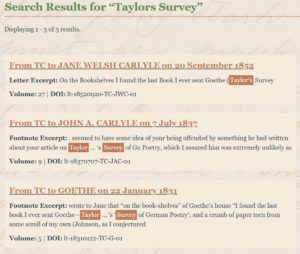Regular readers of this blog (all two or three of you) know that I love letters. Not just to receive them, or write them, but to read them in historical collections. Some years ago, I acquired electronic files of Carlyle’s letters with Ralph Waldo Emerson. Somewhere I picked up a print copy of one of the two volumes, and then a print copy of other letters of his.

From an internet search, I learned about the Carlyle Letters Online. This is a project to put all of the letters of Thomas and Jane Carlyle online in a searchable and highly usable database. This followed the print edition of the letters, which took place from 1970 to 2023, is composed of 50 volumes.
The online version began in 1999. By that time, many letters by the Carlyles that had escaped earlier detection and collection had been found. The number of letters in the online collection is over 9,000 in all, more by Thomas than by Jane.
This review is really only over the first ten volumes of the online collection. which cover the period from 1812 to 1838. I have no idea if I will ever get to the other 40 volumes. In fact, I confess to not having read every letter in Volumes 1, 2, and 3. At that time, I was trying to find letters about specific topics. Beginning with Volume 4, I have read every letter in each volume. It’s taken me a few years to do this, reading one or two letters many nights right before going to bed.
Many of the letters are to family members. Though Carlyle was a man of letters, in the volumes I’ve read, there weren’t many letters to literary men. There were some, of course. By 1838, Carlyle was just starting to gain a following. Soon his circle would expand and include more than Emerson, Mills, and Sterling. I’m anxious to get into those letters.
Thomas often writes in typical Victorian language: flowery, hard to understand, complicated sentences, many references that are now obscure. Sometimes the letters were hard to understand, at least beginning to end. He used a lot of private references we would call coterie speech.

Fortunately, the CLO has copious footnotes on many subject, making the obscure more understandable. It also has a good indexing system. A few years back the index showed on each letter—links to the items in the letter that were indexed. Type about anything Carlyle-related in the index and it brings up results with links to the letters you’ll find that item in. The illustration with this paragraph shows an example of references to one of Carlyle’s less well-known essays.
I don’t know how much time I’m going to put into reading these letters for a while. After finishing Vol. 10 I’m taking some time off from reading them. Oh, I still open the database from time to time and read a letter. I’ll get back to it in a bigger way, maybe next year some time.
While the collecting of the Carlyles’ letters took over a century, and is not over yet, it’s a massive project that has a very specialized audience. I don’t necessarily recommend people rush out and buy either the print letters or start perusing the online letters. For me, they are a source of pleasurable reading.